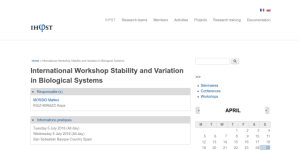Modeling mammary organogenesis from biological first principles: cells and their physical constraints

We have proposed the following principles for the elaboration of a theory of organisms: i) the default state of cell proliferation with variation and motility and b) the principle of organization by closure of constraints. We now propose to use them to frame experiments using experimental biological models and mathematical modeling.
The typical way of doing mathematical modeling in biology is to apply mathematical tools and concepts developed originally in physics. Instead, we propose to use the biological principles mentioned above as bases for our modeling effort.
This model has a biological component, the cells, and a physical component, a matrix which contains collagen fibers. Cells are agents that move and proliferate unless constrained; they exert mechanical forces that i) act on collagen fibers and ii) on other cells. As fibers get organized, they constrain the cells on their ability to move and to proliferate. The model exhibits a circularity that can be interpreted in terms of closure of constraints.
Implementing the mathematical model shows that constraints to the default state are sufficient to explain ductal and acinar formation, and points to a target of future research, namely, to inhibitors of cell proliferation and motility generated by the epithelial cells. The success of this model suggests a step-wise approach whereby additional constraints imposed by the tissue and the organism could be examined in silico and rigorously tested by in vitro and in vivo experiments, in accordance with the organicist perspective we embrace.